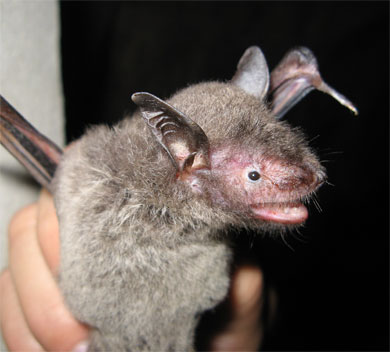Myotis chinensis
Chinese Myotis, Large Myotis
Morphological description Life history Distribution Habitat Roost sites and roosting patterns Emergence and flight pattern Foraging behaviour Echolocation calls Status and protection

Morphological Description
· Dorsal fur is grey- brown. Ventral fur is grey or white-grey.
· This is a relatively large myotis. The ears are rather long, and the feet are noticeably smaller than those of M. ricketti (length of foot is under half the length of the tibia (Bates et al. 1999). Bates et al. (2005) give the forearm length of bats from Myanmar as 65.1-68 mm. Borissenko & Kruskop (2003) give forearm lengths of 65-69 mm for bats in Vietnam.
· The species is closely related to the large mouse-eared bats M. myotis and M. blythii of the Palaearctic.
Life history
· Little known.
Distribution
Also recorded from Myanmar (Bates et al. 2005),Vietnam (Borissenko & Kruskop 2003) and Thailand (in Bates et al. 1999); The Chinese distribution is unclear. Distribution maps are given for M. myotis and M. blythii by Zhang et al. (1997): these probably refer to M. chinensis. Zhang et al.'s (1997) map covers much of eastern China, including southwestern Sichuan, Yunnan, Guangxi, Fujian, Zhejiang, Shaanxi, Inner Mongolia, Changjiang (M. myotis) and Inner Mongolia, Xinjiang, Shaanxi and Guangxi for M. blythii. The relationships among these taxa merits further study.
Habitat
· Little known.
Roost sites and roosting behaviour
· Roosts in caves.
Emergence and flight pattern
· M. chinensis has relatively broad wings and is probably a manoeuvrable species. Its close relatives M. myotis and M. blythii hunt by gleaning (Arlettaz et al. 2001).
Foraging behaviour
· Not known.
Echolocation calls
. Not known.
Status and protection
· There is no estimation of population size in China for this species.
· Chinese myotis bats are at LR/lc, assessed by the Red List of Threatened Species (IUCN, 2006) and are not listed in the Law of the People's Republic of China on the Protection of Wildlife in 1989. Little is known about them.
· Caves should be protected as their habitats.